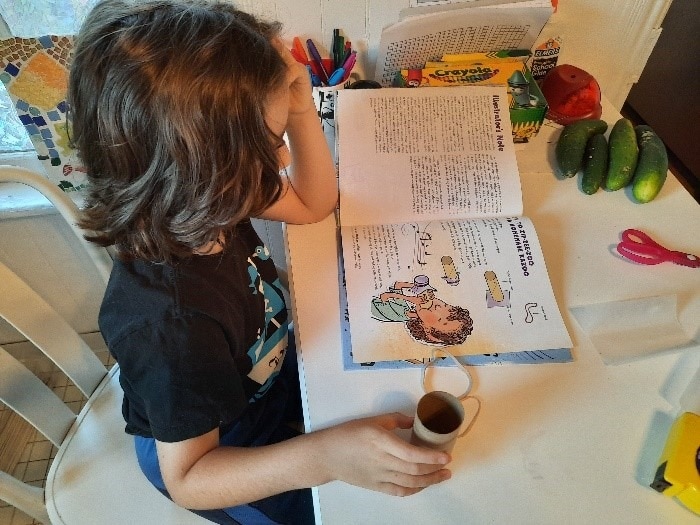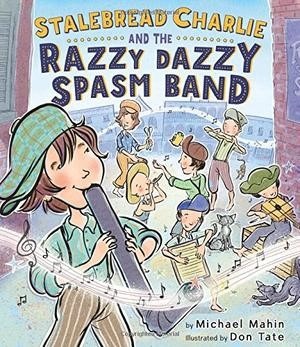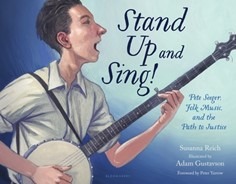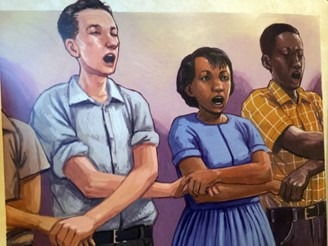NAfME BLOG
Yay Storytime! Musical Adventures with Children’s Picture Books, Part Eleven

/ News Posts / Yay Storytime! Musical Adventures with Children’s Picture Books, Part Eleven
Yay Storytime!
Musical Adventures with Children’s Picture Books, Part Eleven
By Thomas Amoriello Jr.
Immediate Past Chair of the NAfME Council for Guitar Education
The “Yay Storytime! Musical Adventures with Children’s Picture Books” series continues with article number eleven as we focus on works by authors Susanna Reich and Michael Mahin. Stand Up and Sing! Pete Seeger, Folk Music, and the Path to Justice brings the life of folk legend and activist Pete Seeger (1919–2014) to young minds. Stalebread Charlie and the Razzy Dazzy Spasm Band is a fictionalized story based on New Orleans child street musicians from the 1890s who popularized a pre-cursor to jazz know as spasm music with 10-year-old “bandleader” Emile “Stalebread Charlie” Lacoume.
Please feel free to leave comments on social media for open dialog or reach out to me at tamoriel@frsd.k12.nj.us to share which music-themed children’s picture books have been a success in your classroom. On behalf NAfME, I would like to thank Ms. Reich and Mr. Mahin for sharing their thoughts with the membership.
You can read more about Ms. Reich in “Yay Storytime! Musical Adventures with Children’s Picture Books, Part Nine,” in which she was originally introduced to NAfME “Music in a Minuet” readers on October 30, 2020, featuring her book Fab Four Friends: The Boys Who Became the Beatles.
Your mother was a musicologist, as was Pete Seeger’s father ironically. Were you exposed to folk songs at a young age and influenced by the American Folk Music Revival?
Very much so. My mother had a Master’s degree in Music Education and seemed to have a song for every occasion. When I was very young, she played albums like Woody Guthrie’s “Songs to Grow On,” Marais and Miranda, and Pete Seeger. Later I discovered Paul Robeson, Joan Baez, Odetta, the Kingston Trio, the Weavers, and Peter, Paul and Mary. In middle school and high school I was listening to Joni Mitchell, Judy Collins, Eric Andersen, Simon & Garfunkel, and Brits like Donovan and the Incredible String Band.
Stand Up and Sing! can inspire many musical lesson plans for teachers with game songs, dance tunes, spirituals, as well as protest songs. Have you heard from educators about your book?
Even though Stand Up and Sing! is a picture book, the story, images, and concepts are quite sophisticated. Teachers are using it in 2nd–5th grade, sometimes even 6th. Pete’s protest songs have particular resonance today, since kids are hearing about protests in the news and in some cases participating in them. But not everything Pete recorded is about protest. As you mentioned, there are also timeless, traditional folk tunes from all over the world, playful and silly songs for young children, spirituals, work songs, and more. Many of them tie in easily to a standard curriculum.
“Teachers are using ‘Stand Up and Sing!’ in 2nd–5th grade, sometimes even 6th.”
Your book shines light on the many aspects of Mr. Seeger’s life as an activist for social justice, unions, civil rights, and the environment. Your book can really give parents and educators an opportunity to strike up a conversation or introduce a topic to children.
Definitely. Pete was involved in every social justice movement of the 20th century and into the 21st—from union organizing in the ’30s and ’40s, to marching with Dr. King and protesting the Vietnam War in the ’60s, to the environmental movement and the building of the sloop Clearwater, to anti-nuclear protests and Occupy Wall Street. So there’s a lot to discuss, and both the book and his music provide a great entryway to sharing and learning.
Pete Seeger was also a banjo teacher and even wrote a method called How to Play the 5 String Banjo. He taught children at schools and summer camps. Respectfully, he really was quite good at pickin’ an’ grinnin’, well frailing and up-picking to be more precise.
Pete was a very fine banjo player and had a beautiful tenor voice, as well. Kids find out in the book that musical accomplishment doesn’t happen overnight. Pete was obsessed with the banjo from an early age and worked long and hard to master it. I should mention, too, that the illustrator of the book, Adam Gustavson, is also a musician, and he was careful to depict every instrument and historical event accurately in the images.
Pete Seeger wanted folks of all types singing the chorus during his concerts as he felt it was his best music. He really re-introduced America to its folk song roots and was forefront during the Civil Rights and anti-war movements of the 1960s; he really knew the power of music to influence and inspire. Would you like to share with NAfME members any final thoughts and perhaps a few current artists who are carrying the torch for Mr. Seeger’s vision?
Pete’s vision was about bringing people together in community through song. Living nearly a century through times of war, fear, and greed, he never gave up hope for a more caring, compassionate, peaceful world. If you look at the lineup for this year’s Clearwater Festival (which was virtual), you’ll see a wide variety of artists who carry his torch in their own ways, some with topical songs and others with new takes on traditional folk music. I especially like The Mammals/Mike & Ruthy. Also, several generations of Woody Guthrie’s family carry on the tradition, and Ani DiFranco is doing some interesting things.
What would you recommend as essential Pete Seeger listening to our younger NAfME music educators who are just being introduced to his life from reading this article?
I’d start with “If I Had a Hammer,” “Where Have All the Flowers Gone?”, “Turn, Turn, Turn,” “Little Boxes,” “Waist Deep in the Big Muddy,” “Guantanamera,” “Wimoweh,” and “Bells of Rhymney.” Happy listening!
Michael Mahin is an award-winning children’s author and produced screenwriter whose books have been recognized by the New York Times, New York Public Library, NPR, Parent’s Choice, the California Reading Association, and the Jr. Library Guild, among others. His recent picture book When Angels Sing: The Story of Carlos Santana won illustrator Jose Ramirez the prestigious 2018 Society of Illustrators Original Art Gold Medal.
In the author notes to Stalebread Charlie and the Razzy Dazzy Spasm Band you state, “This story contains two universal and important truths: It takes courage to be creative, and creativity (and music) can make the world a better place.” Please elaborate for our NAfME readers about your thoughts on creativity and music making.
On a basic level, I think creativity gives kids the ability to be more compassionate, more caring, and more confident. In my experience, people tend to think of creativity in terms of the thing they create—a song, a painting, a sculpture. But the truth is, creativity is a mindset. It’s a way of approaching the world (and its problems) with an open mind that sees the world not only in terms of what exists, but what could exist.
This is what I hope my books introduce kids to—creativity as a mindset. It takes guts to think differently and to challenge the status quo, whether that’s an external status quo or an internal status quo that exists in the form of habits of thought or assumptions about truth that we’ve been fed since we were children. Creativity is an incredible gift, but it’s not a gift we are born with—it’s a gift we give.
You also include a page at the end of the book with a “How to Zip-Zee-Zoo on a Homemade KAZoo.” This makes for a great lesson plan along for an elementary class with your book.
Yes, I hope so! Plus, kazoos are just fun.
You also incorporate many cool early jazz scats. How many of these did you write down before the one that felt right made the story?
A billion. LOL. The creative process for writing a story is no different than writing music for a song. You toy with ideas, most of which are terrible, but you trust the process, and you keep exploring. Over time you learn to trust this process, even though it’s messy and slow and imprecise. And eventually you stumble upon something that feels right. Either you like the emotion, or you like the way the words sound and feel next to each other. And you ask yourself, “How can I create more of that feeling?”
So you go back to refining and revising or “thinkering and tinkering”—that’s a line from as my book about Leo Fender which is coming out next spring from Christy Ottaviano Books/Henry Holt called Gizmos, Gadgets, and Guitars: The Story of Leo Fender. That line, like so many others, was born out of this process—lots of words on a page until you find the ones that capture whatever it is you’re going for. But here’s a secret—sometimes I don’t know what I’m looking for until I find it.
Stalebread Charlie and his friends are street musicians (and homeless) in 1895. They want to create something unique to feed their bellies as well as feed their souls with music. What was the initial spark of this story, and have you witnessed some creative street musicians in our current times? Your thoughts?
I have to give credit to my brother for finding this story initially. And when he told me about it, it just seemed too good to not be a kids’ book already. But, amazingly, no one had told the story yet. So I started doing research and just loved what I learned. All the names like Stalebread and the Razzy Dazzy Spasm Band were all just too good to be real. But they were!
There wasn’t a whole lot written about them at the time, which is why this book is a fictionalization of what might have happened. But what I really admired was Stalebread’s decision not to let life beat him down, to pull himself up by his bootstraps and figure how to survive using his creativity. I’ve always admired that about street musicians and buskers. Sure some of them are just trying to make a little money, but on the other hand, these are musicians and artists who are investing in their craft; they’re putting in their 10,000 hours, just playing for anyone who will listen, trying to get good enough to catch some sort of break that takes them to the next level.
How has your life as a musician influenced your writing or vice versa?
Music was something I believed in and loved, and I knew if I could find a way to share that with kids, I’d have something special. Not that I’m the first writer to write about music and musicians, but because of my background, it seemed like a good path to follow for me. After my first book, Stalebread Charlie and the Razzy Dazzy Spasm Band, I made a conscious effort to focus on music and musicians because of all the good “lessons” that creativity teaches. Kids’ books should never just be about the “lesson,” in my opinion, but I do enjoy knowing these books have a deeper value and meaning. Also, I’ve gotten so much fulfillment out of music and my own experience playing in bands, that I think I just wanted to share that. I wish I could capture the feeling of jamming with a live band, the feeling of being fully engaged and in the moment and connected to your bandmates and the audience—that presence is magic.
You also have children’s picture books with Carlos Santana and Muddy Waters as the subject. What factors helped you decide on those two music legends?
I just loved that these were two stories about people who started playing as kids, and who used their creativity to lift themselves out of poverty and against all odds managed not only to make their own lives better, but made everybody’s lives better through the gift of their music. What’s important to me about these stories isn’t just their success, but the struggle they endured to get there. That struggle is a key lesson I hope kids get from my books—creativity isn’t a product; it’s a process that is filled with failure and struggle and persistence and most of all, practice. A whole lot of practice.
“Creativity isn’t a product; it’s a process that is filled with failure and struggle and persistence and most of all, practice. A whole lot of practice.”
What are some great ways that children can stay creative, musically speaking, in the current pandemic virtual world that can assist school-based music educators?
Family music time! And vinyl. LOL. One of the reasons I left my last band (an all-’80s cover band where I was one of the lead singers and the lead guitarist), was that after 12 years of having a great time, my priorities had changed. I had a family and wanted to spend more time with them. One of the reasons I had stayed in my band for so long was that I wanted them to see how fun it was being in a band, so that they would know that about music. But once I quit, I had to find another way to try to stoke their enjoyment.
I’ve only gotten into vinyl over the last year or so, but I am hooked. The way we make this fun is by letting the kids DJ. The key is buying records the kids want to listen to. So, next to my Grant Green and Thievery Corporation records, I’ve got Taylor Swift and the Trolls 2 soundtrack. It’s a sacrifice you make for your kids. LOL. We do this with Alexa and Spotify too, just go around the room, each person choosing a song during dinner. Simple and fun way to integrate music while also letting your kids express their own tastes.
Another thing we do is family music time. I started breaking out the acoustic and playing folk songs and sea shanties and blues and stuff they could sing along to. And it kinda just took off. Now, my daughter will call out requests ranging from “Haul Away, Joe” and “Take this Hammer,” to “Dirty Old Town” and “A Pair of Brown Eyes” by the Pogues. There’s something fun about seeing your 7-year-old daughter sing, “One summer evening drunk to hell I sat there nearly lifeless” that really warms the heart. But seriously, it does warm the heart, because she’s loving it, and she’s loving music, and she’s loving sharing that with me and our family, and that’s the real goal, I’ve realized—instilling the love of music. She may not be the next Bonnie Raitt, but she doesn’t have to be. She just has to know that the magic of music is there for her, if she wants it.
Read past articles by Thomas Amoriello Jr.:
- Yay Storytime! Musical Adventures with Children’s Picture Books, Part Ten
- Yay Storytime! Musical Adventures with Children’s Picture Books, Part Nine
- Yay Storytime! Musical Adventures with Children’s Picture Books, Part Eight
- Kidz Are Gonna Rock
- Yay Storytime! Musical Adventures with Children’s Picture Books, Part Seven
- Guitar Class in 50 States: Coda
- Yay Storytime! Musical Adventures with Children’s Picture Books, Part Six
- From Sting to Sky: Interview with Ex-Scorpions Guitarist Uli Jon Roth
- Yay Storytime! Musical Adventures with Children’s Picture Books, Part Five
- A Grownup Conversation with Raffi
- Yay Storytime! Musical Adventures with Children’s Picture Books, Part Four
- A Conductor’s Tale: Interview with American Young Voices Conductor Francisco J. Núñez
- Yay Storytime! Musical Adventures with Children’s Picture Books, Part Three
- A Cultural Treasure: Interview with Sharon Isbin, Julliard Classical Guitar Program Founder
- The Season’s Greeting’s Guitarist: Trans-Siberian Orchestra’s Al Pitrelli
- Yay Storytime! Musical Adventures with Children’s Picture Books, Part Two
- The Student Teacher in the Guitar Classroom
- Double Trouble: Interview with Innovative Musician Gabriel Guardian
- The Patriotic Guitarist: Master Sergeant Alan Prather of “The President’s Own”
- Interview with Progressive Funk-Rock Guitarist DeWayne “Blackbyrd” McKnight
- Heavy Metal Guitar: Neo-Classical Style
- Heavy Metal Guitar: From Times Square to Netflix and Beyond
- Make a Sound! Interview with Drummer Michael Bland
- What about the Electric Bass?
- An Article for Jazz Educators: Interview with Guitarist Kevin Eubanks
- Hip Hop Empowers: Interview with Harlem-Raised, Boston-Based Hip Hop Artist Billy Dean Thomas
- Heavy Metal Guitar Style: Virtuoso Shred Guitar with Toby Knapp
- Adult Education: Rock Camp
- Musical Adventures with Children’s Picture Books
- Empowering the Musician in Your Classroom
About the author:
 Thomas Amoriello Jr. is the Immediate Past Chair of the NAfME Council for Guitar Education and is also the former Chairperson for the New Jersey Music Education Association (NJMEA). He has had more than fifty guitar and ukulele advocacy articles published in music education journals in Michigan, Ohio, Virginia, Washington, Illinois, Rhode Island, and New Jersey. Tom has taught guitar classes for the Flemington Raritan School District in Flemington, New Jersey, since 2005 and also teaches at Hunterdon Academy of the Arts. He has earned a Master of Music Degree in Classical Guitar Performance from Shenandoah Conservatory and a Bachelor of Arts in Music from Rowan University. During his time on the NJMEA board he directed guitar festivals and drafted the proposal to approve the first ever NJMEA Honors Guitar Ensemble.
Thomas Amoriello Jr. is the Immediate Past Chair of the NAfME Council for Guitar Education and is also the former Chairperson for the New Jersey Music Education Association (NJMEA). He has had more than fifty guitar and ukulele advocacy articles published in music education journals in Michigan, Ohio, Virginia, Washington, Illinois, Rhode Island, and New Jersey. Tom has taught guitar classes for the Flemington Raritan School District in Flemington, New Jersey, since 2005 and also teaches at Hunterdon Academy of the Arts. He has earned a Master of Music Degree in Classical Guitar Performance from Shenandoah Conservatory and a Bachelor of Arts in Music from Rowan University. During his time on the NJMEA board he directed guitar festivals and drafted the proposal to approve the first ever NJMEA Honors Guitar Ensemble.
Tom is an advocate for class guitar programs in public schools and has been a clinician presenting his “Guitar for the K–12 Music Educator” for the Guitar Foundation of America Festivals in Charleston, South Carolina, and Columbus, Georgia; Lehigh Valley Guitar Festival in Bethlehem, Pennsylvania; Philadelphia Classical Guitar Society Festival, Philadelphia, Pennsylvania; NAfME Biennial Conferences in Baltimore and Atlantic City; as well as other state music education conferences in New Jersey, Massachusetts, New York, and Virginia. He has twice been featured on episodes of “Classroom Closeup-NJ,” which aired on New Jersey Public Television. He is the author of the children’s picture books A Journey to Guitarland with Maestro Armadillo and Ukulele Sam Strums in the Sand, both available from Black Rose Writing. He recently has made a heavy metal LP recording with a stellar roster of musicians, including former members of Black Sabbath, Whitesnake, Ozzy Osbourne, Yngwie J. Malmsteen’s Rising Force, and Dio that was released on H42 Records of Hamburg, Germany. The record was released on 12-inch vinyl and digital platforms has received favorable reviews in many European rock magazines and appeared on the 2018 Top 15 Metal Albums list by Los Angeles KNAC Radio (Contributor Dr. Metal). The follow-up recording “Dear Dark” was recently released by Ice Fall Records on cassette (EP) and features former members of Megadeth, King Diamond, TNT and Dokken. He is also a music journalist for Boston Rock Radio and interviews many popular rock musicians. Visit thomasamoriello.com for more information.
Interested in reprinting this article? Please review the reprint guidelines.
The National Association for Music Education (NAfME) provides a number of forums for the sharing of information and opinion, including blogs and postings on our website, articles and columns in our magazines and journals, and postings to our Amplify member portal. Unless specifically noted, the views expressed in these media do not necessarily represent the policy or views of the Association, its officers, or its employees.
December 11, 2020. © National Association for Music Education (NAfME.org)
Published Date
December 11, 2020
Category
- Uncategorized
Copyright
December 11, 2020. © National Association for Music Education (NAfME.org)












